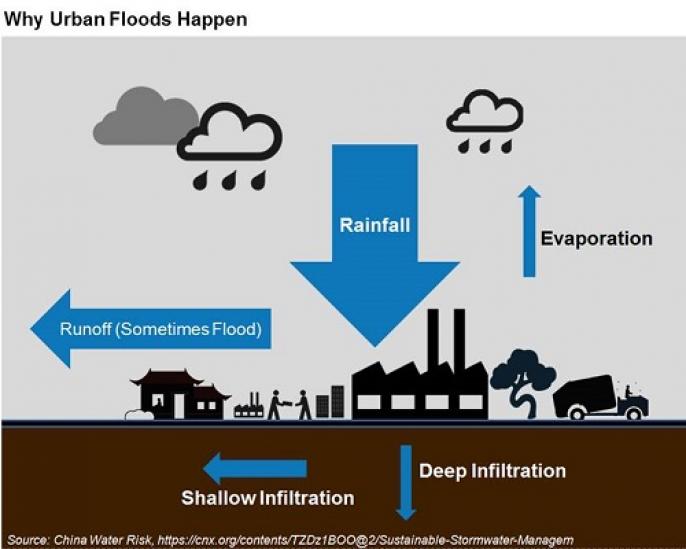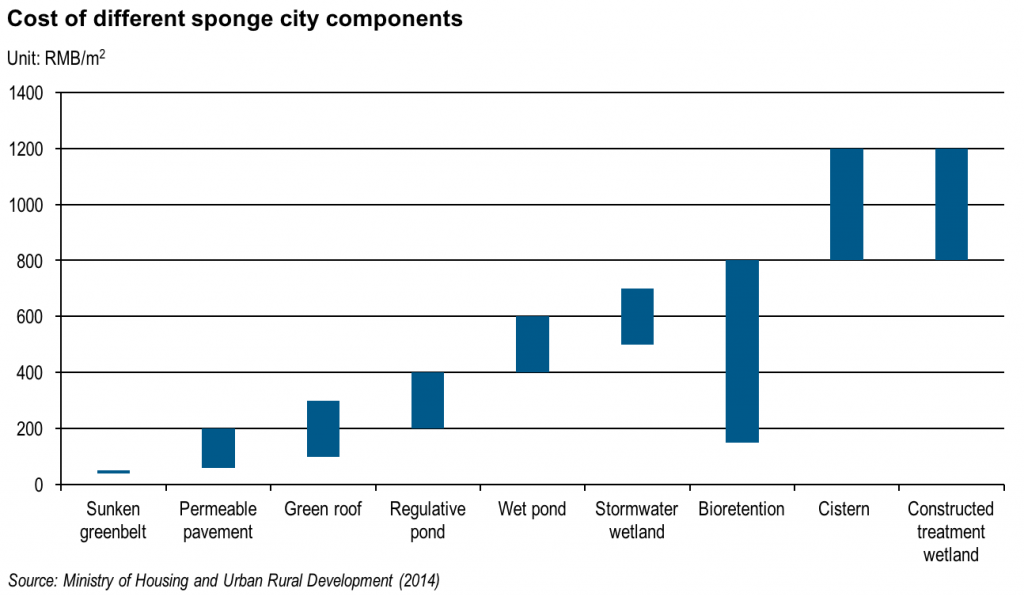Sponge Cities: An Answer To Floods
More and more cities in China are experiencing floods every year. The government seems to have found an answer to this, sponge cities. 16 pilot cities are on their way to becoming sponge cities and 14 more were selected this year. Is this the right way forward?
From September to December 2013, the Office of State Flood Control and Drought Relief Headquarters conducted research on flood control and countermeasures. According to the results, 641 cities are at danger of flooding in China.
234 cities flooded in 2013 …
… 641 cities in China are at danger of flooding
… 137 cities experienced floods three time
~ Ministry of Housing and Urban-Rural Development Survey 2013 ~
Flooding is becoming an urgent issue in China. A combination of extreme weather events and old/faulty infrastructure mean that China frequently experiences floods. Every year more than 100 cities are affected by floods. In 2013, the number of cities flooded was 234.1
Another survey of 351 cities in China conducted by Ministry of Housing and Urban-Rural Development (MoHURD), showed that during 2008 – 2010, 62% cities experienced floods, of which 137 cities experienced floods three times, and in 57 cities floods lasted over 12 hours.2 Floods can cause loss of human life, damage buildings and affect the function of a city, which can cost large amounts of money. Just how much can it cost?
Losses can amount to billions & urban areas are more prone to flooding
According to Chinese researchers, the direct economic loss from floods in China for 2000-2010 amounted to around RMB 1.1 trillion and for 2011-2013 it amounted to RMB712.2 billion3. This means that the average annual loss for 2000-2010 rose from RMB98.2 billion to RMB237.4 billion in more recent years. In 2014, direct economic losses was RMB157.4 billion.
Economic loss from floods between 2011-2013 was RMB712.2 bn
Economic loss from floods is also significant for cities: the flood in Shenzhen in 2008 caused around RMB1.2 billion in economic loss; the flood in Beijing in July 2012 killed 79 people and caused RMB11.6 billion economic loss; and the flood in Ningbo in 2013 caused about RMB33 billion economic loss. And the above numbers are only direct economic losses. The amounts become even more significant if they include indirect economic loss, e.g., disruption to communication, transportation systems, shortage of raw material supply etc.
Indeed, urban areas are more prone to flooding as the earth is covered by tarmac and concrete, making it very difficult for water to infiltrate the ground. Runoff can become very large and after accumulation from upstream to downstream resulting in big impacts.

Beijing’s drainage system was built for the rainfall with a return period only one to three years.
Drainage systems were designed to deal with runoff in urban areas, through pipelines buried underground. However, the drainage system in China wasn’t built for extreme weather conditions. For example, the drainage system in Beijing was designed for rainfall with a return period of only one to three years. When extreme rainfall happens, which could be very frequent under the background of climate change, the amount of water is greater that this return period and so is too much for the drainage system resulting in flooding.
With China’s urbanization rising from 36% in 2000 to 54% in 2013, more and more people and assets are exposed to flood risk. This year, Premier Li Keqiang emphasized the need for catastrophe insurance to deal with the impact of extreme climate in the Government Work Report in 2016.
Urban solutions to flooding: Retrofit the existing drainage or build a sponge city?
One solution to flooding is to retrofit existing drainage systems with larger pipes and more efficient deployment. This is the most straightforward but also probably the most expensive and disruptive way. According to Chinese researchers’ cost analysis of the retrofitting of urban sewer systems in Shanghai, the direct cost amounts to RMB3,786/m using the conventional method, and RMB5,501/m using trenchless technology.
Retrofitting costs can rise by 20% factoring in transport disruptions
In reality the cost can be much higher considering the impact of the residents and commercial activities plus disruptions in transportation. The same researchers above say that costs can rise by 20% should delays in transportation be factored in.
Retrofitting the existing drainage system would take a long period of time to complete. In contrast, features of sponge cities can be implemented quicker, at lower cost (more in section below) and with less disruption.
In China, a ‘sponge city’ refers to the “sustainable development concept of city including flood control and water conservation“, according to the Opinions of the General Office of the State Council.6 Similar concepts exist in other countries like the Low Impact Development (LID) in North America and the Sustainable Urban Drainage System (SUDS) in the UK, which has been going on for 10 years already.
In the US different kinds of LID have proved successful in different experiments and practices, e.g. permeable pavement, which can reduce 50-93% of runoff on average and a LID rain garden can reduce 40-97% of runoff.
Promising results from China’ sponge city pilots with annual runoff control rate reaching at least 85%
Meanwhile in China, MoHURD uses annual runoff control rate as one of the LID criteria. According to the published results, in the pilot sponge city projects in Beijing, Shanghai and Xinjiang, the annual runoff control rates were at least 85%, i.e., 85% of the runoff can be reduced yearly.8 Moreover, a sponge city functions not only for flood control but can also help with water conservation and water purification.
Sponge cities: a wide range of options with wide-ranging costs
So, are sponge cities a cheap option to reduce flood exposure? There is no straight answer as sponge cities include a wide range of options with wide ranging costs. American researchers9 summarised LID installation cost from different sources from 1999 to 2007 in the US. Results show that the installation cost varies with type, location and economic factors but ranges from around USD22/m2 (constructed treatment wetlands) to USD426/m2 (storm water planter). Accounting for inflation10, the cost would now be from about USD22.9/m2 to USD445/m2, equivalent to RMB149/m2 to RMB2,887/m2.
Data from the pilots in China show even lower costs. MoHURD assessed the cost based on existing LID projects in Beijing.8 The cost ranges from about RMB30/m2 for vegetated filter strips to RMB1,200/m2 for artificial treatment wetlands as shown in the chart below.

Cost comparison must consider the co-benefits of sponge cities
A complete cost comparison between these options and the conventional retrofitting of the drainage system is not straightforward: results would vary widely with local conditions. On top of that, a fair cost comparison should consider the many additional benefits of sponge cities for its residents, such as recreational areas, healthier environment, increased biodiversity, cooler temperatures etc. It is likely that the economic case for such solutions will become clearer as China is moving towards sponge cities.
China marches towards more sponge cities
The concept of sponge cities was proposed in 2012, and then emphasized by President Xi Jinping in the Central Government Conference on Urbanization in December 2013. By 2015, the Guiding Opinions of the General Office of the State Council on Advancing the Construction of Sponge Cities was published to further facilitate the construction of sponge cities.
China’s expanded pilots now include Beijing, Shanghai, Tianjin & other key cities
In April 2015, 16 cities were selected as pilot cities. These cities can in the next three years gain access to funding to help with their sponge city development: municipalities directly under the Central Government can access RMB600 million/year, provincial capital cities RMB500 million/year, the rest RMB400 million/year.11 A year later, a further 14 cities were selected to be pilot cities, including Beijing, Tianjin, Shanghai and Shenzhen.
With the rapid pace of urbanization in China – from 36% in 2000 to 54% in 2013 - an increasing population as well as city assets are facing great risk of flooding. Moreover, with extreme weather events becoming more common thanks to climate change, it’s likely that we will see more sponge cities.
Original article and additional reading is available here.




